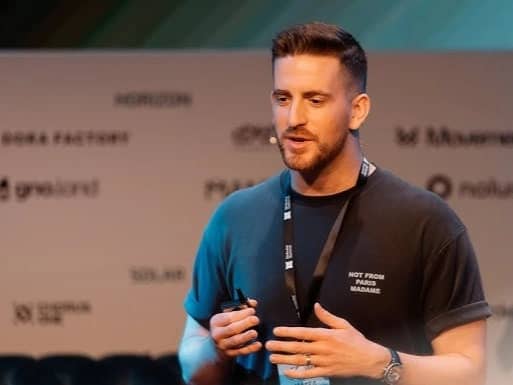订阅 wiki
Share wiki
Bookmark
John Patrick Mullin
John Patrick Mullin
John Patrick Mullin 是 MANTRA 的首席执行官兼联合创始人,MANTRA 是一个旨在代币化 现实世界资产 (RWA) 的 Layer 1 区块链。他也是 SOMA.finance 的首席执行官兼联合创始人,SOMA.finance 是一个完全合规的多资产 DEX 和发行平台。 [1]
教育
马林于2014年获得圣路易斯大学约翰·库克商学院工商管理和国际商务理学学士学位。 后来,他毕业于同济大学和EBS经济与法律大学,分别于2016年获得技术经济与管理硕士学位和管理学硕士学位。 [2]
职业生涯
马林在获得硕士学位后,开始了他在国泰君安(中国的一家金融服务提供商)的研究助理职业生涯。后来,他成为副研究员和高级买方研究分析师,直到2018年1月。在国泰君安工作期间,他还曾担任领英中国和Cointelegraph的撰稿人,Startupbootcamp的导师,以及生命研究所(IOL)的外部合作者。[3]
2018年1月,马林成为FinTech Connector(FTC)的区域总监,这是一个将金融科技企业家和初创企业与金融服务领域的领导者和专家联系起来的在线社区。直到2021年6月,他还是上海FTC的社区合作伙伴。从2018年5月起,他担任LONGHASH、Entrepreneur First和she256的导师。2018年9月,马林加入香港科技大学商学院担任客座讲师,后来在同济大学担任相同职位。[3]
2021年8月,马林成为CLUB DAO的创始合伙人,这是一个由加密货币创始人和爱好者在香港创立的私人会员俱乐部。他还加入Outlier Ventures担任其DeFi Basecamp的导师,并成为Hedera生态系统中DEX和DAO HeliSwap的战略顾问。后来,马林于2020年5月共同创立了MANTRA,目前担任首席执行官,并于2023年5月成为创始协会成员。[3]
面试
金融背景
2022年3月,Globe Official采访了Mullin关于他的金融背景以及在国泰君安的工作经历。在采访开始时,Mullin分享了他如何开始从事传统金融行业:[4]
“我当时走的是一条比较传统的道路,尽管我很早就接触了比特币。我在2012年或2011年,还在大学的时候就买了我的第一个比特币。那时,我仍然走的是一条比较传统的道路,试图在投资银行工作。最终我在一家中国证券公司工作,名叫国泰君安证券,是中国最大的国有投资银行之一。我是第一批在该公司工作的外国人,或者像他们在香港说的那样,是“老外”。”
“他们决定专注于创建一个全球化的研究部门,涵盖当时五年计划中概述的各种新兴技术。这包括区块链和加密货币、机器学习、自动化和其他新兴技术。因为我个人已经对这些领域感兴趣多年,我很快意识到我在公司内部的机会不会是关系银行家、并购专家或定量分析师,因为我缺乏必要的技能,比如中文语言能力。我唯一能做的就是成为一个主题专家。我利用这一点,将自己定位为区块链和加密货币专家。我开始为公司研究这些技术,撰写报告,并与高级管理层和公司高层分享,以教育他们了解这些新兴技术。”
然后他分享了他如何开始在加密货币领域工作,以及他如何遇到他的联合创始人Rodrigo Quan Miranda和Will Corkin:[4]
“更广泛的研究重点的一部分包括为一般的金融科技公司组织聚会,邀请创始人分享他们的经验。我举办活动,通常包括饮料和社交,我是最早在上海用英语做这件事的人之一。大约在2016年到2018年,在第一波大的加密货币公众浪潮中,我组织了许多加密货币聚会。这导致我参与了一些公司,最终我辞掉了工作,全职在一家我帮助的加密货币公司工作。我搬到了香港,在那里我们发展了业务,这标志着我第一次涉足创业。”
“那次创业惨败,但我从这次经历中学到了很多,并通过它认识了许多我现在的商业伙伴。在那之后,我们正在考虑下一步该怎么做。我和我现在的几个合伙人一起努力获得一个特殊的许可证,稍后当我们谈到Soma时我会讨论这个问题。这项努力面临着它自身的挑战,因为就在我们即将取得重大突破的时候,COVID-19爆发了。作为一个苦苦挣扎的创业者,我度过了这段时期,直到我们推出,一年半后,我们已经从三个人发展到全球超过50人。这真是一段旋风般的旅程。”
当被问及在中国工作学到了什么时,Mullin回答说:[4]
“说实话,真正让我印象深刻的一件事是人际关系的重要性,在中国被称为“关系”,以及它们如何显著影响你的商业网络和生活。我们雇佣的许多人,我们达成的交易,以及我们进行的投资都源于我建立的网络。这是一个强大的工具,可以用“你的人脉就是你的净资产”这句话来概括,我绝对相信这一点。这对我来说是一个主要的收获。”
“另一个收获是在那段时间培养了自信,这让我有信心尝试新事物。 这不是自大; 而是要有一种冒险和尝试的心态,即使成功没有保证。 尽管经历过失败,但这种方法使我在生活中取得了很多成就。 很多人可能具备能力,甚至可能具备更好的技能,但他们缺乏冒险的意愿。”
“当我们开始时,它本质上是一个可互操作的DeFi协议,旨在支持各种金融应用程序,主要面向零售消费者。 目标是让个人在个人财富和财务方面感到宾至如归和轻松自在。 关键的基本要素包括跨链DeFi功能(仍在开发中)和一个非托管平台。 与银行等托管平台不同,一切都以非托管方式执行。 此外,用户必须完全控制平台的运行方式。 这是否全部实现是另一回事。 开发和建立初创公司很困难,而且我们的业务和运营方式也发生了变化。 但是,核心要素仍然存在。 我们创建了一个复杂的系统,其中包含随着平台和业务的增长而开发的各种组件。 现在,我们专注于拥有一个多链DeFi生态系统。”
关于 MANTRA
2023年11月,The Resilient Podcast 采访了 Mullin,讨论了他从国际教育到早期沉浸于加密货币的历程。作为首席执行官,他专注于为全球金融开发 Web3 协议和应用程序。 Mullin 反思了 区块链 领域的创业挑战,强调了监管导航和资产自托管的价值。他还分享了管理职业压力和心理健康的个人见解,强调了诸如教练和健身等策略以增强韧性。 [5]
RWA 代币化
Mullin 在 The Crypto Conversation Podcast 中讨论了 MANTRA 创建代币化生态系统的目标。在采访开始时,他分享了 MANTRA 的愿景声明:[6]
“Mantra 是一个建立在 Cosmos SDK 上的第一层区块链,用于资产代币化和 RWA。我们拥抱应用链理论,开发协议层和应用层,目标是将金融 EOS 系统引入链上。这意味着什么?我举个例子。我们基本上希望实现一键式体验,让用户只需点击一下,即可直接从他们的钱包、手机或桌面上跨链上和链下世界进行交易。无论是处理 加密货币钱包、加密资产、法定货币、证券、房地产或其他投资产品,我们的目标是让所有这些都可以随时随地访问,全天候在线。我们认为链上是未来的在线,我们的使命是利用 Cosmos 技术在实现这一愿景中发挥重要作用。”
“我经常提到,早在 RWA 这个术语出现之前,我们就已经参与了 RWA。就我个人而言,我更喜欢不使用 RWA 这个术语,因为在金融术语中,它代表风险加权资产。对我们来说,代币化是一个更广泛的理论——它关乎几乎所有东西都可以代币化的潜力。然而,并非所有东西都应该被代币化;驾驭所涉及的现实世界的复杂性至关重要。今天,创建代币在技术上很简单,但将它们与现实世界的系统、监管机构、银行整合,并获得必要的许可证才是真正的挑战。在 DeFi 中,你可以 fork 代码,但你无法复制许可证——这个过程需要大量的时间、资源,以及与监管机构的持续互动,以有效地解决他们的担忧。”
“我发现这些挑战既令人生畏,又最终令人满意。它们使工作保持动态和吸引力——无论是驾驭监管环境、解决技术复杂性,还是制定商业策略。市场快节奏的性质确保总有新的问题需要解决。令人鼓舞的是,看到像 Larry 爵士这样的人物倡导资产代币化,这在更广泛的金融界眼中使我们的工作合法化。当我们旨在通过现实世界的专业知识和行业内的合作来引领金融资产的链上转型时,这种认可至关重要。”
在采访结束时,Mullin 分享了他对 10 年后代币化的看法:[6]
“我最近在几周前的伦敦 DAS 上公开预测,与我的小组中的 Avalanche City 和 BNY Mellon 的代表一起,我们将在两年内开发出一种产品,只需单击一下即可在银行账户、经纪公司和钱包之间实现无缝过渡。我坚持这个预测。展望未来 10 年,我设想一个一切都在链上无缝运行的未来,类似于今天的 web 2.0 体验,用户不会区分他们使用的是哪个 区块链,也不会区分他们正在与钱包互动——所有这些都将集成到日常金融互动中。”
Mantra区块链的开发进展
Mantra 推出 1.08 亿美元基金
2025 年 4 月 7 日,Mantra 区块链 网络启动了一项 108,888,888 美元的生态系统基金,旨在加速专注于 现实世界资产 (RWA) 代币化和 去中心化金融 (DeFi) 的初创公司的增长,以应对对稳定、资产支持的数字产品日益增长的需求。
首席执行官 JP Mullin 表示,该基金将采取“开放政策,欢迎全球任何发展阶段的项目,尤其关注 RWA 和 DeFi”。他告诉 Cointelegraph:
“MEF 的论点是投资于构建 RWA 和 DeFi 应用程序以及互补基础设施的顶级团队,这些团队将直接和间接地支持更广泛的生态系统。” [7]
OM 的崩溃
Mantra 的 OM 代币价格在 2025 年 4 月 13 日暴跌超过 90%,在几小时内从大约 6.30 美元跌至 0.50 美元以下。 [8]
在 4 月 14 日在 X 上发布的一篇文章中,联合创始人 JP Mullin 表示,OM 价格的急剧下跌是由中心化交易所引发的强制清算造成的。他解释说,这些行动是在 UTC 周日晚上流动性较低的时段突然采取的,这可能放大了市场影响。
“我们已经确定,OM 市场波动是由中心化交易所对 OM 账户持有人发起的鲁莽强制平仓引发的,”Mantra 联合创始人 John Mullin 在 4 月 13 日在 X 上发表的声明中写道。
“崩盘的时间和深度表明,账户头寸的突然关闭是在没有充分警告或通知的情况下发起的,”他补充说。
Mullin 告诉一位 X 用户,他们认为“特别是”一家交易所应该受到指责,但表示他们仍在“弄清楚细节”。他告诉其他人,有问题的中心化交易所不是 Binance。 [8]
2025 年 4 月 15 日,JP Mullin 通过他的 X 页面表示,他计划销毁他所有的 772,000 个 OM 代币,以回应有关该项目最近崩溃和内幕交易活动的批评。 [9]
“我计划销毁我所有的团队代币,当我们扭转局面时,社区和投资者可以决定我是否已经赢回了它,”Mullin 发布了 [10]
许多社区成员欢迎 Mullin 的承诺,但其他人认为代币销毁可能会打击团队对构建现实世界资产代币化平台的长期承诺。
“这将是一个错误。我们希望团队受到高度激励。销毁激励措施可能看起来是一个好的姿态,但从长远来看会损害团队的积极性,”Crypto Banter 创始人 Ran Neuner 说。
Mullin 建议可以通过去中心化的投票来决定是否销毁 3 亿个团队代币。 [11]
发现错误了吗?
